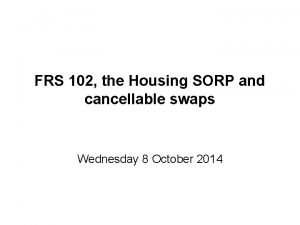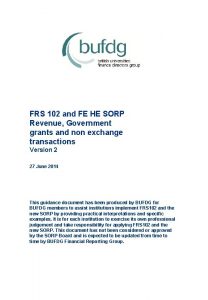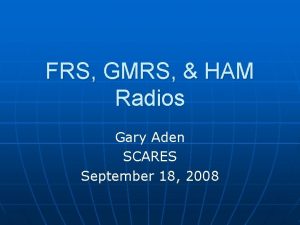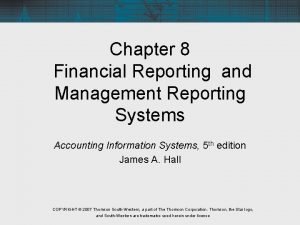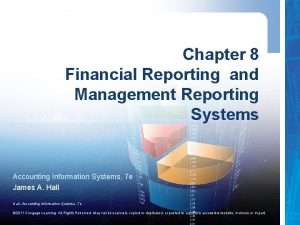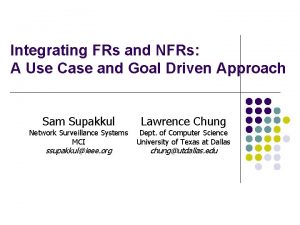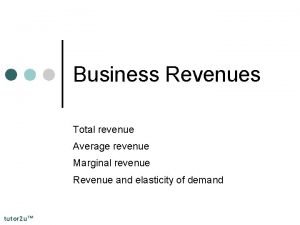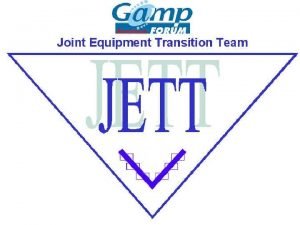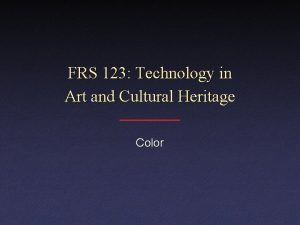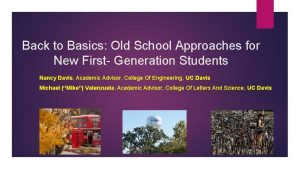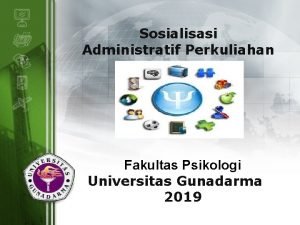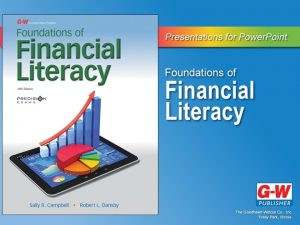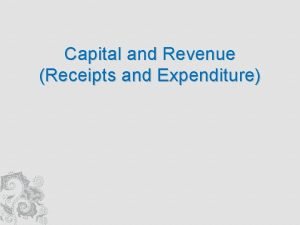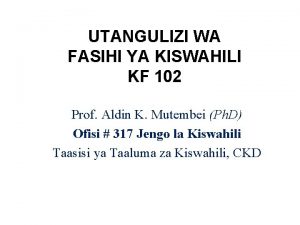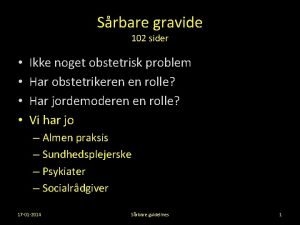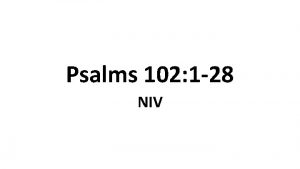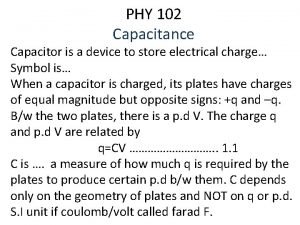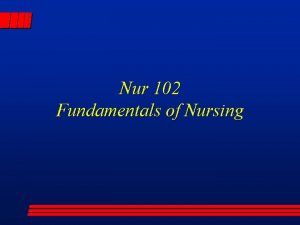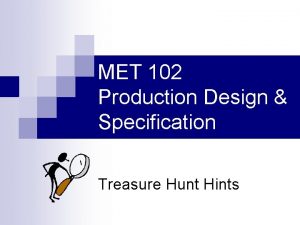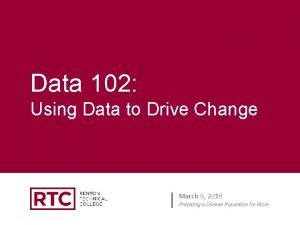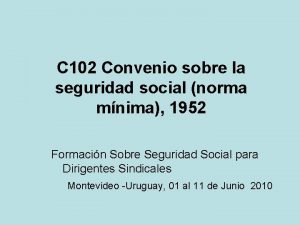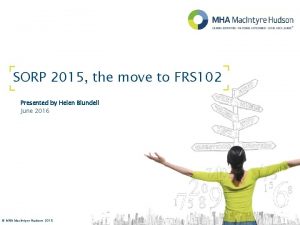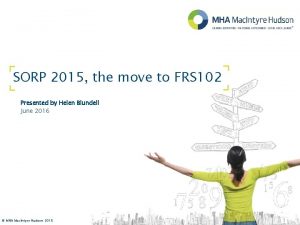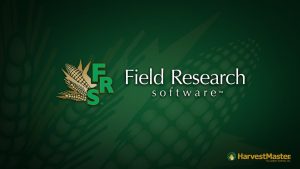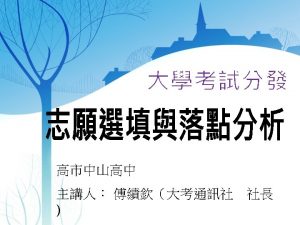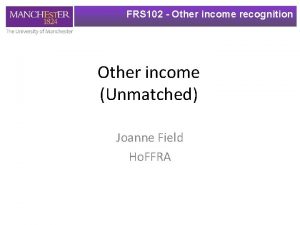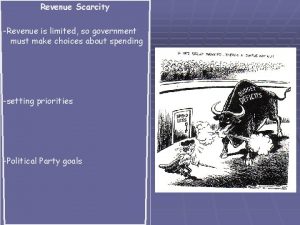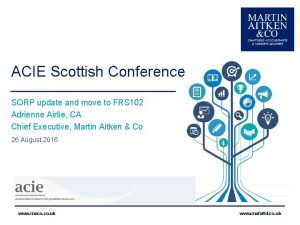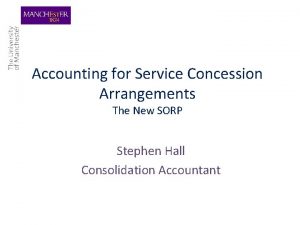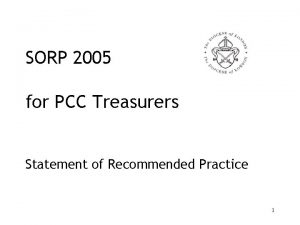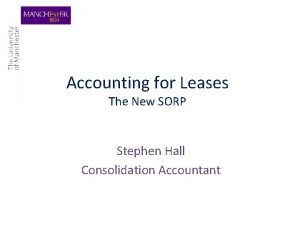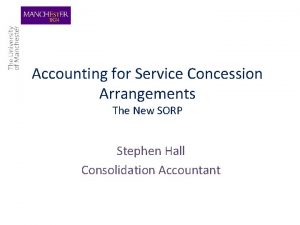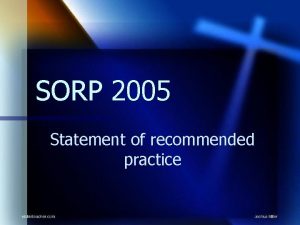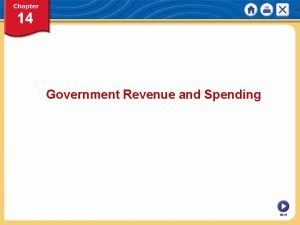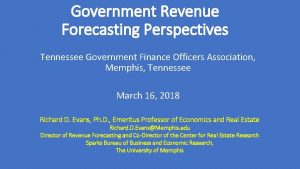FRS 102 and FE HE SORP Revenue Government





























- Slides: 29

FRS 102 and FE HE SORP Revenue, Government grants and non exchange transactions Version 2 27 June 2014 This guidance document has been produced by BUFDG for BUFDG members to assist institutions implement FRS 102 and the new SORP by providing practical interpretations and specific examples. It is for each institution to exercise its own professional judgement and take responsibility for applying FRS 102 and the new SORP. This document has not been considered or approved by the SORP Board and is expected to be updated from time to time by BUFDG Financial Reporting Group.

Introduction Version 2 - 27 June 2014 The FE HE SORP 2015 sets out the accounting policy choices that can be applied for government grants and non exchange transactions. The two options being the accrual model and the performance model. This document aims to provide more detail on when each option is permitted and more detail on how it should be applied – for example identifying performance related conditions. Institutions should also refer to the SORP chapters 17 and 18 which cover government grants and non exchange transactions respectively. This document sets out Pages 2 - 3 Understanding of performance related conditions Pages 4 - 8 Frequently asked questions Pages 9 - 10 A summary of the examples and how they should be recorded within the statement of comprehensive income Pages 11 – 28 a number of worked examples based on actual transactions within institutions, identifying the appropriate accounting treatment in accordance with the SORP. This document will be updated as universities progress through the transition process and further queries are raised for which BUFDG FRG think further guidance for the sector would be useful. Version /Date Key changes Version 1 - 17 April 2014 Version 2 27 June 2014 Minor changes following BUFDG FRG comments on 20 June © 2014 KPMG LLP, a UK limited liability partnership, is a subsidiary of KPMG Europe LLP and a member firm of the KPMG network of independent member firms affiliated with KPMG International Cooperative, a Swiss entity. All rights reserved. 1

Understanding Government grants, Non exchange transactions and Performance related conditions Version 2 - 27 June 2014 Government grants Chapter 17 of the 2015 SORP includes the following definition of government grants: “Government grants are provided by government bodies and do not include donations or funding from other charities or benefactors (which are referred to as non-exchange transactions in FRS 102 and this SORP). Economically government grants and non-exchange transactions may be very similar in that they reflect money which is granted or donated as opposed to a commercial transaction arising under contract. ”. . ”for the purposes of this SORP, where a funding entity receives a significant portion of its income from non-Government sources, it is considered a non-Government entity and therefore funding provided by them would be a non exchange transaction. ” Government grants may be accounted for using the accrual model or the performance model. Under the accrual model income is matched to the benefit to which the grant relates. Under the performance model income is recorded as the performance related conditions to which the income relates are met. Institutions may choose an accounting policy for government revenue grants and a separate policy for government capital grants. The policy chosen must be applied consistently across that class of grant – e. g. The same policy for all revenue grants. Capital grants for land must be accounted for using the performance model. Non exchange transactions Chapter 18 of the 2015 SORP includes the following definition of non exchange transactions: “Non-Exchange Transactions are those transactions whereby an entity receives (or gives) value from/to another entity without directly giving/receiving approximately equal value in exchange. Non-exchange transactions include, but are not limited to, donations of cash, goods and services and endowments. These transactions will include gifts in kind, for example, a donation of an asset or piece of equipment for operational use. A donated asset may be classified as a heritage asset as set out in section 26 of this SORP. . . Non-exchange transactions include grants from private and charitable individuals or organisations including research grants. ” Non exchange transactions must be accounted for using the performance model. Performance related conditions The SORP sets out definitions for performance related conditions and restrictions. However in practice it is recognised that distinguishing between performance related conditions and restrictions is not so simple. This guide intends to assist institutions when making judgements by providing more practical interpretations and specific examples of income. This guide does not, and indeed should not, give definitive guidance to an area where individual circumstances will differ and in all instances professional judgement should be applied. Accounting policy choice When choosing appropriate accounting policies institutions should consider: ■ The impact on surplus and net assets (any deferred capital grants are held as deferred income on the balance sheet), ■ Consistency of accounting for similar grants from government and non government sources, ■ Potential administration time arising from adopting a particular policy, and ■ The future of FRS 102 – indications are that the FRC may review the accrual model in future years. This review MAY result in the accrual model not being permitted for the next version of FRS 102 at which point it is likely that any adjustments arising would result in a prior year adjustment from the change in accounting policy. © 2014 KPMG LLP, a UK limited liability partnership, is a subsidiary of KPMG Europe LLP and a member firm of the KPMG network of independent member firms affiliated with KPMG International Cooperative, a Swiss entity. All rights reserved. 2

Understanding Government grants, Non exchange transactions and Performance related conditions Version 2 - 27 June 2014 Some Basic Principles ■ A performance related condition is a type of restriction ■ The timing of cash receipts should not be the driver for income recognition. Entitlement to the income will be the driver of income recognition rather than the actual cash transaction. ■ In many instances there a number of approaches to classifying performance related conditions. Institutions should be pragmatic and adopt an approach which is simple to implement and likely to result in an appropriate accounting outcome for the institution. Restrictions apply in many circumstances where a donor / grantor has requested a specific use of the funds which restricts the way in which the institutions may spend the funds 3. Performance related conditions form a sub set of restrictions and exist where the restrictions are such that the donor / grantor has stipulated the level of service or units of output on which the funds must be utilised before entitlement to the fund passes. © 2014 KPMG LLP, a UK limited liability partnership, is a subsidiary of KPMG Europe LLP and a member firm of the KPMG network of independent member firms affiliated with KPMG International Cooperative, a Swiss entity. All rights reserved. 3

Frequently asked questions Version 2 - 27 June 2014 This section sets out a number of frequently asked questions: Q 1) So what is a performance related condition in practice? Q 2) Can a grant for revenue and capital spend be treated as one income stream or should it be separated into the capital and revenue elements? Q 3) When do capital grants have performance related conditions and when do they have restrictions? Q 4) What is included within the definition of government grants? Q 5) When does a grant without performance related conditions have a restriction and when is it unrestricted? Q 6) Under the 2007 SORP and related guidance on donations and endowments there is a tendency to classify donations with certain conditions as expendable endowments. What change should we expect under the 2015 SORP? Q 7) How is income classified within the Statement of Comprehensive Income Q 1) So what is a performance related condition in practice? FRS 102 sets out the definition of a performance related condition as being “A condition that requires the performance of a particular level of service or units of output to be delivered, with payment of, or entitlement to, the resources conditional on that performance. ” The critical words within this definition are “level of service” and “unit of output”. When demonstrating that a particular grant includes performance related conditions it will be helpful to come back to these requirements as evidence of the performance related conditions. It is also worth noting that there are frequently a number of ways that performance related conditions can be identified within a particular grant. Frequently one of these options will result in a more logical income recognition profile than another. We would expect institutions to adopt the most logical method as its policy and apply this consistently. As an example: let’s take a typical research grant. The institution will have to develop a detailed bid for the grant setting out the expected hours and other expenditure required including any capital requirements. The research grant awarded will include requirements that the institution has to deliver a milestone, e. g. a report at the end, with perhaps additional milestones along the way. The contract may not identify the original detailed costings within the proposal. Revenue grant considerations In this instance there are two main views on what the performance related conditions are: 1. The grant includes milestones and a final deliverable. These are deemed to be the performance related conditions. In this instance grant income would be recognised as each milestone was met in proportion to the % of work completed to that date. This could result in a mismatch between income and expenditure within the statement of comprehensive income and therefore result in greater volatility in annual results. If the accrual model is adopted (for government grants only) income is matched to costs on an accruals basis as under the current 2007 SORP. 2. Although the grant document may not specify the detailed costing, it was awarded on the basis of the proposal. Therefore there is an expectation of the grantor that the institution will deliver the resources as listed within the proposal. The resources (eg man hours / days and related costs) equate to the “level of service” to be provided and therefore income would be recorded in line with the delivery of these costs. It is reasonable that a grantor anticipates that actual costs may not exactly match the proposal in terms of timing and mix up to a point in time. Therefore it is also reasonable to record income in line with the actual costs incurred. If the accrual model is adopted (for government grants only) income is matched to costs on an accruals basis as under the current 2007 SORP. Whilst both of the above are acceptable interpretations, we expect that the majority of institutions will adopt a bid cost, “level of service”, approach to performance related conditions. This is demonstrated in the second view of performance related conditions above. Capital grant considerations FRS 102 requires that an institution must adopt an accounting policy for each class of grant and indicates that these classes are likely to be capital, revenue and land. The institution must apply its capital grant accounting policy to the capital element of a research contract. In both instances the specific capital purchase has a clear performance related condition i. e. purchasing the asset. Therefore the income in relation to the capital element should be separated from the total grant income and recorded when the asset is purchased. If the accruals model is adopted, on recognition the capital grant element will be shown as deferred income and then released to the SOCI (as funding body income, see Q 7 below) whereas if the performance model is adopted the capital grant element will be recognised immediately as funding body income. © 2014 KPMG LLP, a UK limited liability partnership, is a subsidiary of KPMG Europe LLP and a member firm of the KPMG network of independent member firms affiliated with KPMG International Cooperative, a Swiss entity. All rights reserved. 4

Frequently asked questions Version 2 - 27 June 2014 Q 1) Continued. . . Most research grants are awarded on the basis of a successful proposal which identifies the level of service to be provided. Therefore most research grants will result in income being matched to expenditure, which results in the same accounting treatment as the 2007 SORP accrual approach. This is highly likely to be the case for government research grants where government funded entities have a requirement to demonstrate value for money, which would normally be executed through a robust proposal process. However there are occasional instances where grants are given for a purpose, but with no proposal or requirement to deliver a level of service. Examples have been identified from charities who provide charitable grants to institutions who demonstrate particular expertise in an area of research. These are akin to donations although institutions will be keen to retain the definition of research income rather than donations where the funding is for research (provided Frascati definitions are met). These grants do not have performance related conditions and therefore income is recognised as the institution is entitled to the income, frequently in advance of expenditure being incurred. Such grants may or may not have restrictions in use. Q 2) Can a grant for revenue and capital spend be treated as one income stream or should it be separated into the capital and revenue elements? When applying the performance model it is also necessary to consider income recognition requirements i. e. Income is recognised on entitlement to the income. The institution is entitled to the income when the performance related conditions to which it relates are met. In the same way that the revenue sections of FRS 102 require elements of an income stream to be broken into their constituent parts (eg an asset plus service) the income from grants should be allocated to their constituent parts. The same should be applied for government and non government grants. Therefore grant income should be allocated between capital and revenue elements and income recognised in line with the performance related conditions of each element. It should not be treated as one income stream allocated across the performance related conditions linked to the revenue resources applied. If the performance model is adopted under FRS 102, revenue components of research grants are likely to be accounted as they currently are, effectively identical to the accruals model. However, the capital component of the grant will be recognised as income within the SOCI rather than deferred income released to income within the SOCI over time as under current accounting. Q 3) When do capital grants have performance related conditions and when do they have restrictions? For performance related conditions to exist the grantor / donor needs to stipulate the level of service or unit of output. The requirement to spend on capital or Building A would not meet the definition of performance related conditions unless the donor / grantor specified details about Building A (eg a detailed design specification). ■ A typical research grant may include an element for a specific capital item of equipment. Where this is the case the level of service to be provided includes buying a very specific item of equipment. In this instance the performance related condition is met with the equipment is purchased. Ie income is recognised when the equipment is purchased. ■ A capital grant where the donor / grantor requires the income to be spent on the capital plan or even specific capital projects will include a restriction on how the income should be spent but is unlikely to include performance related conditions. ■ There may be instances of capital grants where the donor / grantor requires the income to be spent on a specific project and also includes details such as the design specification to which the assets must be built. In this scenario there may be performance related conditions arising from the level of service expected during the build phase. Therefore income should be recognised in line with the level of service ie build costs. © 2014 KPMG LLP, a UK limited liability partnership, is a subsidiary of KPMG Europe LLP and a member firm of the KPMG network of independent member firms affiliated with KPMG International Cooperative, a Swiss entity. All rights reserved. 5

Frequently asked questions Version 2 - 27 June 2014 Q 4) What is included within the definition of government grants? The 2015 SORP includes the following relating to the definition of government grants: “Government grants are provided by government bodies and do not include donations or funding from other charities or benefactors. . . ■ Government grants are transfers of resources from Government bodies including, but not limited to: ■ Government departments and their agencies and non-departmental public bodies; ■ local government; ■ EU funding agencies; ■ local and regional funding agencies (e. g. Regional Growth Fund and UK Research Councils); and ■ NHS bodies. For the purposes of this SORP, where a funding entity receives a significant portion of its income from non-Government sources, it is considered a non-Government entity and therefore funding provided by them would be a non exchange transaction. ” Government grants includes governments in foreign jurisdictions and the European government. A UK research council is considered to be a government body. Government grants excludes charities such as the Arts Council which receive the majority of its funding from non governments sources. (e. g. lottery funding) Q 5) When does a grant without performance related conditions have a restriction and when is it unrestricted? Firstly it is important to remember that any grant without performance related conditions will be recognised in income when the institution is entitled to the income. The question of having restrictions or not is only relevant for disclosing which reserves the income is retained in and the related disclosures. Many further and higher education institutions receive expendable charitable donations with specific terms attached to them which are general to the objectives of the institution. The primary activities of further and higher education institutions are teaching and research. Where the terms of the donations contain restrictions that are sufficiently general that the restriction has no material impact, the donation is, in substance unrestricted, and should be accounted for as unrestricted income. Judgement will be required for each institution’s own circumstances. © 2014 KPMG LLP, a UK limited liability partnership, is a subsidiary of KPMG Europe LLP and a member firm of the KPMG network of independent member firms affiliated with KPMG International Cooperative, a Swiss entity. All rights reserved. 6

Frequently asked questions Version 2 - 27 June 2014 Q 6) Under the 2007 SORP and related guidance on donations and endowments there is a tendency to classify donations with certain conditions as expendable endowments. What change should we expect under the 2015 SORP? This is a critical question and the accounting treatment may differ depending on the classification of transactions. The 2007 SORP and related guidance resulted in donations with restrictions for which the restrictions required spend over a period of more than 2 years being accounted for as expendable endowments. Under the 2015 SORP the following may arise to classify these transactions: The 2015 SORP states that a time frame for expected expenditure of less than two years is unlikely to create an expendable endowment. The inference from this is that a time frame for expected expenditure of more than 2 years is more likely to create an endowment. Whilst this guidance refrains from giving a specific time cut off it advises that: ■ For donations with performance related conditions where the income is to be spent over a period of time it is vital that the donor has included very specific evidence of the level of service or units of output in order to demonstrate performance related conditions. ■ For donations where the income is to be spent over a time frame of greater than 5 years this guidance supports a view that these are expendable endowments as the inference is that the institution would need to invest the sums and that in only very rare instances would a donation with performance related conditions exist. Examples 32 and 33 within this guide give 2 examples of income to fund expenditure over 3 years, one of which is classified as an endowment the other a grant with performance related conditions. 2007 SORP Indicators 2015 SORP Recognition Expendable endowments • covers potentially any restricted donations other than permanent endowments • Donation income recognised in STRGL Donor indicates that the funds are to be invested in medium to long term pending spend down; or Income to be spent over a time frame > 5 years Restrictions not forming performance related conditions Restricted donations Rarely (*): Where the conditions previously assessed as restrictions are now assessed as performance related conditions. (* very specific evidence of the level of service or units of output in order to demonstrate performance related conditions) Donations subject to performance related conditions Recognise in full on entitlement Include in “donations and endowments” line Credit to endowments and hold in endowments until spent Recognise in full on entitlement Include in “donations and endowments” line Credit to restricted reserve and hold in restricted reserve until spent Recognise income as performance related conditions are met Include income in “donations and endowments” line © 2014 KPMG LLP, a UK limited liability partnership, is a subsidiary of KPMG Europe LLP and a member firm of the KPMG network of independent member firms affiliated with KPMG International Cooperative, a Swiss entity. All rights reserved. 7

Frequently asked questions Version 2 - 27 June 2014 Q 7) How is income classified within the Statement of Comprehensive Income? The guidance within this question relates to classification of income under both the accrual model and the performance model. The 2015 SORP includes the following references to the classification of income: 16. 11 Research income may be received as commercial revenue transactions, from government sources and from nongovernment sources. In all instances, the income should be recorded within research within the Statement of Comprehensive Income Government grants 17. 13 An institution adopting the performance model must recognise income from Government grants within the Statement of Comprehensive Income when performance-related conditions are met. 17. 11. . . . The income should be recorded within the Statement of Comprehensive Income under the relevant heading of funding body grants, research grants or other income as appropriate to the nature of the grant. Non exchange transactions 18. 6: Institutions may wish to distinguish donations for research and similar grants from other donations and endowments by recording income within research, donations and endowments or other income as appropriate. This guidance includes further clarity on how universities should interpret the SORP. ■ Any funding received from funding bodies e. g. HEFCE should be included within the funding body income including funding body research allocations. ■ Research income should be identified in line with the Frascati definitions of research which should result in consistency with the HESA requirements. ■ Capital grants should be recorded as follows: ■ Capital grants from funding bodies should be recorded within funding body income. Institutions adopting the performance model may wish to include an additional line item in the SOCI if income in a particular year was material to aid the readers of the accounts. ■ Capital grants from other sources should be recorded within donations and endowments. Once again institutions adopting the performance model may wish to include an additional line item in the SOCI if income in a particular year was material to aid the readers of the accounts. © 2014 KPMG LLP, a UK limited liability partnership, is a subsidiary of KPMG Europe LLP and a member firm of the KPMG network of independent member firms affiliated with KPMG International Cooperative, a Swiss entity. All rights reserved. 8

Summary of Examples 1 HEFCE recurrent grant GG Yes In line with teaching related activity 2 Studentships - Principal GG Yes In line with level of service 3 Studentships - Agent Rev No Commission only - In line with services provided 4 HEFCE Capital grant (CIF) GG No When entitled to the income 5 HEFCE capital grant (project) GG No When entitled to the income 6 As Example 1 but where there is franchising of teaching GG Yes In line with teaching related activity 7 NHS contracts GG Yes 8 Tuition fees Rev N/A 9 Research grant RC GG Yes In line with resources used / costs 10 EPSRC equipment grant GG Yes When the equipment is purchased 11 Philanthropic donation for use in research NET No When entitled to the income 12 Charitable trust donation for use in research (with significant capital element) NET No When entitled to the income 13 Capital grant: Medical Research Council GG No When entitled to the income 14 Capital Grant British Heart Foundation NET No When entitled to the income ( ) 15 Capital grant-match funding GG and NET No See detail 16 Research Grant – Charity NET Yes In line with resources used / costs 17 Research Grant: Charity post doc fellowship NET Yes In line with resources used / costs 18 Research Grant – Charity with audit requirements NET Yes In line with resources used / costs 19 Industrial Research Grant: example 1 Rev N/A In line with services provided 20 Industrial Research Grant: example 2 Rev N/A In line with services provided 21 Grant for a collaborative research project GG Yes Institutions share only - In line with resources used / costs In line with teaching related activity In line with teaching services provided Donations and endowments Investment income Other income Research grants and contracts Tuition fees and education contracts Recognition under the Performance model Funding body grants Performance related condition? Title Classification * Ref Version 2 - 27 June 2014 ( ) © 2014 KPMG LLP, a UK limited liability partnership, is a subsidiary of KPMG Europe LLP and a member firm of the KPMG network of independent member firms affiliated with KPMG International Cooperative, a Swiss entity. All rights reserved. 9

Summary of Examples Donations and endowments Investment income Other income Research grants and contracts Tuition fees and education contracts Recognition under the Performance model Funding body grants Title Performance related condition? Classification * Ref Version 2 - 27 June 2014 22 Services rendered Rev N/A In line with services provided 23 Capital grant: Royal Society Award NET No When entitled to the income 24 Capital Grant St Mary’s Trust NET No When entitled to the income 25 Privately funded capital grant NET No When entitled to the income 26 Regional development agency grant with output conditions GG Yes In line with build spend 27 Arts Council museum grant NET Yes In line with services provided 28 Unrestricted donation NET No When entitled to the income 29 Restricted Donation NET No When entitled to the income 30 Donations with restrictions NET No When entitled to the income 31 Donation with performance related conditions NET Yes In line with level of service 32 Restricted donation with service level and time requirement NET Yes In line with services provided 33 Restricted expendable endowment NET No When entitled to the income 34 Expendable Endowment NET No When entitled to the income ( ) 35 Restricted Permanent Endowment NET No When entitled to the income ( ) 36 Restricted Permanent Endowment NET No When entitled to the income * Rev – revenue transaction GG – Government Grant ( ) NET – Non exchange transaction © 2014 KPMG LLP, a UK limited liability partnership, is a subsidiary of KPMG Europe LLP and a member firm of the KPMG network of independent member firms affiliated with KPMG International Cooperative, a Swiss entity. All rights reserved. 10

Examples Version 2 - 27 June 2014 Background / Key terms and conditions Example 1 – HEFCE recurrent grant Example 2 – – Studentships - Principal A funding council passes government funding for HE to the institution in the form of block grants, in a number of elements with separate calculations, and subject to a financial memorandum. One element within the block grant relates to the teaching grant – the T block. A University receives from a Research body , funding for studentships. The University is acting as a principal. Indicators of the University acting as principal include; • University has control over students selected to receive studentships • University can determine how studentships are split between different subjects Is this a revenue, government grant or non exchange transaction? Government grant What performance related conditions or restrictions exist? Whilst the grant letters are fairly broad in terms, in substance they anticipate the provision of teaching related activity over the year. In addition the funding has specific student numbers attached – supporting the view that the funding is to support teaching over the year. This “level of service” (i. e. provision of teaching related activity over the year) is considered to be a performance related condition. The grant letters include reference to the specific years in which the grants will be received and the purpose of the spend for those years, i. e. the level of service to be provided over those years. Income should be recognised in line with the delivery of teaching i. e. the “level of service” over the year to which the grant relates. Where the substance of a transaction is that the seller acts as principal, the entity should report income based on the gross amount received or receivable in return for its performance under the contractual arrangement. What is the appropriate accounting and disclosure requirements for institutions adopting the performance model? Government Grant HEFCE is a government agency and therefore this is a government grant. HEFCE does not get anything directly in return and therefore this is NOT a revenue transaction. The grant will be disclosed within funding body grants within income and expenditure. The levels of service referenced within the letter are performance related conditions. Where a University has discretion over which students awards are payable to, the selection of the students is defined as a performance condition. In cases where the University acts as principal, income should be accounted for once - as a gross studentship and the billing of tuition fees to the student should not be included in fee income. Where a University has received funding at the balance sheet date but not all the performance conditions have been met (for instance the University has discretion over which students awards are payable to) then the unspent income should be deferred as a liability at the balance sheet date. If there is no discretion over which students are paid then the amounts unpaid at the year end should not be deferred. What is the appropriate accounting and disclosure requirements for institutions adopting the accrual model? Other comments: Under the accrual model income will be recorded in line with the services provided. In practice this will either be in line with spend or straight-line across the period of the studentship whichever as appropriate. Funds for general research studentships cannot be treated as endowments. This is because teaching and research are primary purpose activities of the University so cannot be restricted. © 2014 KPMG LLP, a UK limited liability partnership, is a subsidiary of KPMG Europe LLP and a member firm of the KPMG network of independent member firms affiliated with KPMG International Cooperative, a Swiss entity. All rights reserved. 11

Examples Version 2 - 27 June 2014 Example 3 - Studentships - Agent Example 4 – HEFCE Capital grant (CIF) Background / Key terms and conditions A University receives from a Research body , funding for studentships. The University is acting as an agent. HEFCE passes government funding for HE to the HEI in the form of capital allocations which the institution allocates to specific assets. Is this a revenue, government grant or non exchange transaction? Revenue Government grant It is not expected that there would be any circumstance under which a University would receive agency fees in the form of a government grant as it would suggest that the contract has commercial substance, the fee being for the provision of administrative services. HEFCE is a government agency and therefore this is a government grant. HEFCE does not get anything directly in return and therefore this is NOT a revenue transaction. What performance related conditions or restrictions exist? N/A This arrangement does not include performance related conditions as the University can choose the nature of the capital build. The nature of the CIF funding leads to the conclusion that there are no restrictions in use as the capital expenditure is line with the University’s ongoing estates plan and therefore part of normal ongoing operations. What is the appropriate accounting and disclosure requirements for institutions adopting the performance model? What is the appropriate accounting and disclosure requirements for institutions adopting the accrual model? Where the substance of a transaction is that the seller acts as agent, it should report as income the commission or other amounts received or receivable in return for its performance under the contractual arrangement. In the University example there is no commission but by default this means that in an agency situation the income associated with the studentship should be excluded from the accounts. Income should be recognised on entitlement within the income and expenditure account. This will give rise to a mismatch with future depreciation charges incurred on the capitalised assets. Accrual model not permitted for revenue transactions. Record as a creditor until the grant is spent. At this time the creditor is recorded as deferred income or income depending on whether the grant is spent on revenue or capital or revenue items respectively. The deferred income must be allocated between creditors due within one year and due after more than one year. The grant will be disclosed within funding body grants. Recognise in income on a systematic basis over the expected useful life of the asset to which the grant relates. The income will be disclosed within funding body grants. Other comments: Agency arrangements will typically include the following characteristics: (a) the seller has disclosed the fact that it is acting as agent; (b) once the seller has confirmed its customer’s order with a third party, the seller will normally have no further involvement in the performance of the ultimate supplier’s contractual obligations. © 2014 KPMG LLP, a UK limited liability partnership, is a subsidiary of KPMG Europe LLP and a member firm of the KPMG network of independent member firms affiliated with KPMG International Cooperative, a Swiss entity. All rights reserved. 12

Examples Version 2 - 27 June 2014 Example 5 – HEFCE capital grant Example 6 – As Example 1 but where there is franchising of teaching to another institution Background / Key terms and conditions UK Research Partnership Investment Fund – HEFCE capital support for certain buildings. Institution claims cash drawdown as the building works progress. A funding council passes government funding for HE to the institution in the form of block grants, in a number of elements with separate calculations, and subject to a financial memorandum. One element within the block grant relates to the franchising of teaching to other education providers (typically further education colleges). Is this a revenue, government grant or non exchange transaction? Government grant HEFCE is a government agency and therefore this is a government grant. HEFCE does not get anything directly in return and therefore this is NOT a revenue transaction The funding council is a government agency and therefore this is a government grant. The funding council does not get anything directly in return and therefore this is NOT a revenue transaction. What performance related conditions or restrictions exist? Although there are milestones to draw down cash these are not performance related conditions. See further detail within the frequently asked questions on page 4. Whilst the grant letters are fairly broad in terms, in substance they anticipate the provision of teaching related activity over the year. In addition the funding has specific student numbers attached – supporting the view that the funding is to support teaching over the year. This “level of service” (i. e. provision of teaching related activity over the year) is considered to be a performance related condition. Within the total student numbers, a specific number will be taught by a third party provider. The institution is restricted to spending the cash on certain buildings. There are no ongoing restrictions in the use of the buildings. What is the appropriate accounting and disclosure requirements for institutions adopting the performance model? Recognise income when entitled to the income as restricted income and hold as a restricted reserve. When expenditure is incurred on the capital item the restricted reserve should be released to general reserves. The grant will be disclosed within funding body grants. What is the appropriate accounting and disclosure requirements for institutions adopting the accrual model? Record as a creditor until the grant is spent on the asset to which it relates. At this time the creditor is recorded as deferred income. The deferred income must be allocated between creditors due within one year and due after more than one year. This is a jointly controlled operation and therefore the institution should only record as Income its share of the block grant, which should be recognised in line with the delivery of teaching i. e. the “level of service” over the year to which the grant relates. The net grant will be disclosed within funding body grants within income and expenditure. Under the accrual model, income will be recorded in line with the services provided. i. e matched to the costs incurred. Since it is the franchisee which incurs the costs, the franchisor should only record its share of the block grant. Recognise in income on a systematic basis over the expected useful life of the asset to which the grant relates. The grant will be disclosed within funding body grants. © 2014 KPMG LLP, a UK limited liability partnership, is a subsidiary of KPMG Europe LLP and a member firm of the KPMG network of independent member firms affiliated with KPMG International Cooperative, a Swiss entity. All rights reserved. 13

Examples Version 2 - 27 June 2014 Example 7 - NHS contract Example 8 – Tuition fees Background / Key terms and conditions NHS passes funding for a certain number of students to receive education for NHS professions. Funding is received for individual academic years. Students pay tuition fees to an institution for a specific year of teaching. Some of this tuition fee is paid by the government through the Student Loan Company (“SLC”). Is this a revenue, government grant or non exchange transaction? Government grant Revenue (exchange transaction) NHS funding is received from NHS bodies – all of which are part of government. The students receive the benefit of the teaching rather than the NHS therefore this is NOT a revenue transaction. (See SORP 2015 16. 3) The student is paying tuition fees in return for education. The fact that some of the cash is paid by the SLC does not change the nature of this transaction. The SORP clarifies that the SLC transaction is accounted for between the student and the SLC as cash in return for a loan. What performance related conditions or restrictions exist? The grants are awarded for teaching certain student numbers for specific academic years. Not applicable The teaching of students is the “level of service” to be delivered over time. This level of service is considered to be the performance related condition. What is the appropriate accounting and disclosure requirements for institutions adopting the performance model? Income should be recognised in line with the delivery of teaching the “level of service” over the year to which the grant relates. What is the appropriate accounting and disclosure requirements for institutions adopting the accrual model? Under the accrual model income will be recorded in line with the services provided. Other Comments It is common in the sector that NHS contracts remain unsigned for a number of months into the academic year. However, provided there is past evidence that these are signed and that the final contracts include performance related conditions in relation to the students and academic year, then the income can be recognised in line with these expected performance related conditions. The grant will be disclosed within tuition fees and education contracts within income and expenditure. Recognise income in line with the education provided. The income will be disclosed within tuition fees and educational contracts. Not applicable © 2014 KPMG LLP, a UK limited liability partnership, is a subsidiary of KPMG Europe LLP and a member firm of the KPMG network of independent member firms affiliated with KPMG International Cooperative, a Swiss entity. All rights reserved. 14

Examples Version 2 - 27 June 2014 Example 9 – Research council grant Example 10 – EPSRC Equipment grant Background / Key terms and conditions Defined research project or activity over fixed period with funding agreed in advance based on (proportion of) full costing. The institution is required to deliver a completion report as part of the research contract terms. Contribution towards purchasing of scientific equipment (application for grant value includes reference to expected period of research undertaking and nature of anticipated research activity for 24 months). Is this a revenue, government grant or non exchange transaction? Government grant The research council is a government agency and does not receive the direct benefit from the research undertaken. The EPSRC is a government agency and does not receive the direct benefit from the research undertaken. What performance related conditions or restrictions exist? The grant is awarded on the basis of pre-agreed budgets for project spend. These pre-agreed budgets set out the resources required to deliver the project. They are the “level of service” or “units of output” that meet the definition of performance related conditions within FRS 102. The institution is restricted on the use of the cash – i. e. it has to be spent on certain scientific equipment. What is the appropriate accounting and disclosure requirements for institutions adopting the performance model? The delivery of the completion report is considered a milestone rather than a performance related condition. Since in this instance the grant requires the purchase of very specific equipment this would meet the definition of a performance related condition which is met on purchasing the equipment. Recognise income in line with the level of service (resources applied). Recognise income when the performance related condition is met Where actual spend profiles differ from the budgeted spend profiles the income should be recorded in line with the actual spend. The grant will be disclosed as part of research income. Cash in advance of expenditure is held as deferred income with disclosures to demonstrate the source of grants deferred, likely to be by sponsor type. The grant will be disclosed within research grants and contracts. What is the appropriate accounting and disclosure requirements for institutions adopting the accrual model? Under the accrual model income will be recorded in line with the services provided. Record as a creditor until the grant is spent on the asset to which it relates. At this time the creditor is recorded as deferred income. The deferred income must be allocated between creditors due within one year and due after more than one year. Recognise in income on a systematic basis over the expected useful life of the asset to which the grant relates. The grant will be disclosed within research grants and contracts Other comments: A typical RCUK grant will be granted based upon a proposal which includes the resources applied to the research and therefore the level of service. © 2014 KPMG LLP, a UK limited liability partnership, is a subsidiary of KPMG Europe LLP and a member firm of the KPMG network of independent member firms affiliated with KPMG International Cooperative, a Swiss entity. All rights reserved. 15

Examples Version 2 - 27 June 2014 Background / Key terms and conditions Example 11 – Philanthropic donation for use in research Example 12 - Charitable trust donation for use in research (probable significant capital element) £ 100 k donation to support Paediatric Gastroenterology research, at discretion of named academic. £ 50 k donation to support development of Open Source Microscope supported research activities. There are no specific output requirements from the donation. Is this a revenue, government grant or non exchange transaction? Non exchange transaction Donating individual not a government body. Charities are not considered part of government and therefore this is not a government grant. What performance related conditions or restrictions exist? Despite the specific element of research, paediatric gastroenterology is a significant part of HEI and departmental core research activities. Therefore this donation in effect has no restrictions. Despite the specific element of research, open source microscope research is a significant part of HEI and departmental core research activities. Therefore this donation in effect has no restrictions. See SORP 17. 39 ‘An institution should consider its own circumstances to determine if funds are restricted or not. ’ There is no restriction in relation to capital spend as the donation does not specify whether the donation should be spent on capital or revenue items. Recognise as a donation for research when the institution is entitled to the income. The income will be disclosed within research grants and contracts. Any subsequent spend on capital will be capitalised within property plant and equipment with depreciation charges in future years. What is the appropriate accounting and disclosure requirements for institutions adopting the performance model? The grant will be disclosed within research grants and contracts. What is the appropriate accounting and disclosure requirements for institutions adopting the accrual model? Accrual model not permitted for non exchange transaction. Other comments: This example gives a mismatch between income and expenditure recognition in the statement of comprehensive income. This example gives a mismatch between income and expenditure recognition in the income and expenditure account. © 2014 KPMG LLP, a UK limited liability partnership, is a subsidiary of KPMG Europe LLP and a member firm of the KPMG network of independent member firms affiliated with KPMG International Cooperative, a Swiss entity. All rights reserved. 16

Examples Version 2 - 27 June 2014 Background / Key terms and conditions Example 13 – Capital grant: Medical Research Council Example 14 – Capital Grant British Heart Foundation Medical Research Council (MRC) funding towards construction of new research facility (L Block). British Heart Foundation Strategic Initiative Application – funding towards construction of new research facility. Funding is collected as the building progresses. Is this a revenue, government grant or non exchange transaction? The MRC is a government agency and therefore this is a government grant. What performance related conditions or restrictions exist? Although there are milestones to draw down cash these are not performance related conditions. See further detail within the frequently asked questions on page 4. Non exchange transaction Charities are not part of government and therefore this is not a government grant. The institution is restricted to spending the cash on certain buildings. Although there are milestones to draw down cash these are not performance related conditions. The institution is restricted to spending the cash on certain buildings. There are no ongoing restrictions in the use of the buildings. What is the appropriate accounting and disclosure requirements for institutions adopting the performance model? Recognise income when entitled to the income as research grants and contracts. When expenditure is incurred on the capital item the restricted reserve should be released to general reserves. The SORP requires that the income is classified under the most relevant heading. Following the Francati definitions this income would be classified as research. What is the appropriate accounting and disclosure requirements for institutions adopting the accrual model? Record as a creditor until the grant is spent on the asset to which it relates. At this time the creditor is recorded as deferred income. The deferred income must be allocated between creditors due within one year and due after more than one year. Recognise income when entitled to the income as restricted income and hold as a restricted reserve. When expenditure is incurred on the capital item the restricted reserve should be released to general reserves. The SORP requires that the income is classified under the most relevant heading. Following the Francati definitions this income would be classified as research. Accrual model not permitted for non exchange transactions. Recognise in income on a systematic basis over the expected useful life of the asset to which the grant relates. The grant will be disclosed within research. © 2014 KPMG LLP, a UK limited liability partnership, is a subsidiary of KPMG Europe LLP and a member firm of the KPMG network of independent member firms affiliated with KPMG International Cooperative, a Swiss entity. All rights reserved. 17

Examples Version 2 - 27 June 2014 Background / Key terms and conditions Example 15 – Capital Grant – Match Funding Example 16 – Research Grant – Charity The Institution receives a £ 5 m BIS capital grant for specific equipment with the institution given flexibility on the choice of equipment. Defined research project or activity over fixed period with funding agreed in advance based on (proportion of) full costing. This is matched by a charitable grant for the same amount and relating to the same equipment. The combined capital sum is £ 10 m. Is this a revenue, government grant or non exchange transaction? The BIS grant is a government grant. Non exchange transaction The charitable grant is a non exchange transaction. Charities are not part of government and therefore this is not a government grant. What performance related conditions or restrictions exist? The Institution is restricted on the use of the cash, i. e. it has to be spent on certain scientific equipment. The grant is awarded on the basis of pre-agreed budgets and project spend. These pre-agreed budgets set out the man hours and other expenses required to deliver the project. They are the “level of service” or “units of output” that meet the definition of performance related conditions within FRS 102. However this required spend does not meet the definition of a performance related condition The delivery of the completion report is considered an administrative task rather than a performance related condition. What is the appropriate accounting and disclosure requirements for institutions adopting the performance model? Recognise income when grant receivable as restricted income and hold as a restricted reserve. When expenditure is incurred on the capital item the restricted reserve should be released to general reserves. Recognise income in line with the level of service (man hours and other expenses incurred). The grant will be disclosed within donations and endowments. The grant will be disclosed within research grants and contracts. Where actual spend profiles differ from the budgeted spend profiles the income should be recorded in line with the actual spend. This applies to both the BIS and charity element. What is the appropriate accounting and disclosure requirements for institutions adopting the accrual model? BIS grant Accrual model not permitted for non exchange transactions. Record as a creditor until the grant is spent on the asset to which it relates. At this time the creditor is recorded as deferred income. The deferred income must be allocated between creditors due within one year and due after more than one year. Recognise in income on a systematic basis over the expected useful life of the asset to which the grant relates. The deferred capital grant release will be disclosed within donations and endowments Charity grant Can only apply performance related condition. Therefore a significant mismatch arises between the 2 elements of the grant. © 2014 KPMG LLP, a UK limited liability partnership, is a subsidiary of KPMG Europe LLP and a member firm of the KPMG network of independent member firms affiliated with KPMG International Cooperative, a Swiss entity. All rights reserved. 18

Examples Version 2 - 27 June 2014 Background / Key terms and conditions Example 17– Research Grant: Charity post doc fellowship Example 18 – Research Grant – Charity with audit requirements Grant is for the employment of a named individual to work in a specific area of research. Early stage clinical research: Association between DNA damage and high-risk plaques. Audited returns confirming spend are required to support the grant. Is this a revenue, government grant or non exchange transaction? Non exchange transaction Charities are not part of government and therefore this is not a government grant. What performance related conditions or restrictions exist? The “level of service” which meet the definition of performance related conditions is the requirement that the named individual delivers specified research over a period of time. The grant is awarded on the basis of pre-agreed budgets and project spend. These pre-agreed budgets set out the resources required to deliver the project. They are the “level of service” or “units of output” that meet the definition of performance related conditions within FRS 102. The delivery of the audited returns is considered an administrative task rather than a performance related condition. What is the appropriate accounting and disclosure requirements for institutions adopting the performance model? Recognise income in line with the level of service (delivery of research by an individual over time). Where actual spend profiles differ from the budgeted spend profiles the income should be recorded in line with the actual spend. The grant will be disclosed within research grants and contracts. What is the appropriate accounting and disclosure requirements for institutions adopting the accrual model? Accrual model not permitted for non exchange transactions. Other comments: Institutions should ensure that the terms of the arrangement do not result in an agency arrangement. Recognise income in line with the level of service (resources). Where actual spend profiles differ from the budgeted spend profiles the income should be recorded in line with the actual spend. The grant will be disclosed within research grants and contracts. Accrual model not permitted for non exchange transactions. . © 2014 KPMG LLP, a UK limited liability partnership, is a subsidiary of KPMG Europe LLP and a member firm of the KPMG network of independent member firms affiliated with KPMG International Cooperative, a Swiss entity. All rights reserved. 19

Examples Version 2 - 27 June 2014 Background / Key terms and conditions Example 19 – Industrial Research Grant: example 1 Example 20 – Industrial Research Grant: example 2 Contract with 3 rd party commercial entity. The overall aim of the project is to enhance our understanding of room heating/cooling and converge on what comprises the most efficient room heating/room cooling. Contract with 3 rd party commercial entity. “To improve maintenance management and processes for locomotive systems at [company] by developing an intelligent self-learning and adaptive incident management”. 6 monthly progress reports. Software developed to be used and owned by the third party. IP developed to be owned by the 3 rd party. Contract includes a number of progress deliverables including reports. Is this a revenue, government grant or non exchange transaction? Revenue (exchange transaction) The customer receives the output of the research in return for the fixed fee paid. What performance related conditions or restrictions exist? Not applicable What is the appropriate accounting and disclosure requirements? Recognise income in line with the service provided. The grant will be disclosed within research grants and contracts. (This is a research contract) Other comments: Income recognition should take into account the long term nature of these contracts. When contracts are undertaken over a long time (more than 1 year) profit should be recorded in line with the progress of work once it is reasonably certain that a profit will be achieved. Any losses should be accounted for as soon as they are identified. © 2014 KPMG LLP, a UK limited liability partnership, is a subsidiary of KPMG Europe LLP and a member firm of the KPMG network of independent member firms affiliated with KPMG International Cooperative, a Swiss entity. All rights reserved. 20

Examples Version 2 - 27 June 2014 Background / Key terms and conditions Example 21 – Grant for a collaborative research project Example 22 – Services rendered University X is awarded a multi-million pound grant by a UK research council to fund a five year project that involves three other HEIs. Laboratory analysis work carried out for a private sector customer at a fixed price agreed in advance. University X is required to deliver a completion report for the whole project as part of the research grant terms. Is this a revenue, government grant or non exchange transaction? Government grant Revenue (exchange transaction) The research council is a government agency and does not receive the direct benefit from the research undertaken. The commercial customer receives the output of the laboratory work in return for the fixed fee paid. What performance related conditions or restrictions exist? The grant is awarded on the basis of pre-agreed budgets and project spend by each of the four HEIs. These pre-agreed budgets set out the man hours and other expenses required to deliver the project. They are the “level of service” or “units of output” that meet the definition of performance related conditions within FRS 102. Not applicable The delivery of the completion report is considered a milestone rather than a performance related condition. What is the appropriate accounting and disclosure requirements for institutions adopting the performance model? This is a jointly controlled operation and therefore all four institutions, including University X, must recognise their share of the grant as income in line with the level of service (man hours and other expenses incurred). Recognise income in line with the services provided. The income will be disclosed within other income. Where actual spend profiles differ from the budgeted spend profiles the income should be recorded in line with the actual spend. The grant will be disclosed within research grants and contracts. Cash in advance of expenditure is held as deferred income with disclosures to demonstrate the source of grants deferred, likely to be by sponsor type. What is the appropriate accounting and disclosure requirements for institutions adopting the accrual model? Under the accrual model income will be recorded in line with the services provided. Not applicable © 2014 KPMG LLP, a UK limited liability partnership, is a subsidiary of KPMG Europe LLP and a member firm of the KPMG network of independent member firms affiliated with KPMG International Cooperative, a Swiss entity. All rights reserved. 21

Examples Version 2 - 27 June 2014 Background / Key terms and conditions Example 23 – Capital grant: Royal Society Award Example 24– Capital Grant St Mary’s Trust Royal Society (RS) contribution to costs of construction of a specific new laboratory facility (building refurbishment). Joint 50/50 contribution to full cost of St Mary’s Library building refurbishment. Funding is collected as the building progresses. The RS pay for construction costs only. The college/department cover direct costs and VAT. Funding is received on completion of the building. Is this a revenue, government grant or non exchange transaction? Non exchange transaction Charities are not part of government and therefore this is not a government grant. What performance related conditions or restrictions exist? Although there is a milestone at the end of the project to draw down cash this is not a performance related condition. See further detail within the frequently asked questions on page 4. Although there are milestones to draw down cash these are not performance related conditions. See further detail within the frequently asked questions on page 4. The institution is restricted to spending the cash on certain buildings. There are no ongoing restrictions in the use of the buildings. Recognise income when entitled to the income (on grant award) as restricted income and hold as a restricted reserve. When expenditure is incurred on the capital item the restricted reserve should be released to general reserves. Recognise income when entitled to the income as restricted income and hold as a restricted reserve. When expenditure is incurred on the capital item the restricted reserve should be released to general reserves. The grant will be disclosed within donations and endowments. Accrual model not permitted for non exchange transactions. What is the appropriate accounting and disclosure requirements for institutions adopting the performance model? What is the appropriate accounting and disclosure requirements for institutions adopting the accrual model? © 2014 KPMG LLP, a UK limited liability partnership, is a subsidiary of KPMG Europe LLP and a member firm of the KPMG network of independent member firms affiliated with KPMG International Cooperative, a Swiss entity. All rights reserved. 22

Examples Version 2 - 27 June 2014 Background / Key terms and conditions Example 25 – Privately funded capital grant Example 26 - Regional development agency grant with output conditions Contribution to costs of construction of a specific new laboratory building. The finished building should be used to deliver a specific activity, but over no specified period. Grant from Regional Development Agency (RDA) to construct and establish facilities, the use of which is expected to achieve a number of regional target outcomes over the following years. The institution collects cash as construction progresses. The grant has very specific requirements for the build including budgets, square footage and quality of space. The finished building has to be used for a particular purpose. Outputs under performance bond have value to a number of regional stakeholders, but not direct to RDA. Is this a revenue, government grant or non exchange transaction? Non exchange transaction. The private donor is not a government body and does not receive direct benefit from the donation. Government grant as the RDA is a government agency What performance related conditions or restrictions exist? The donation has been provided subject to restrictions on how the funding is spent. However these are not considered performance related conditions. In this instance there is a specific level of service required during the build process as the contract specifies the detailed build requirements. This level of service meets the definition of performance related conditions which exist during the build phase. The collection of cash during construction is deemed as an administration task rather than performance related conditions. Upon completion of the building there are no further performance related conditions. The final building may have restrictions on how it can be used, but it is highly likely that the nature of these restrictions are in effect unrestricted in relation to the overall purpose of the institution. Funding is collected in instalments, subject to construction and installation progress. However these are considered administration tasks for cash collection and not performance related conditions. Provided the institution believe that outcome conditions will be achievable at the contract outset (e. g. through appropriate due diligence at grant award) these outcome measures are again not performance related conditions. What is the appropriate accounting and disclosure requirements for institutions adopting the performance model? The income will be recognised on entitlement as restricted income. The restricted reserve created will be released to unrestricted reserves during construction of the building. This example gives a mismatch between income and expenditure recognition. The grant will be disclosed within donations and endowments. What is the appropriate accounting and disclosure requirements for institutions adopting the accrual model? Accrual model not permitted for non exchange transactions. Recognise income in line with the building expenditure. At each balance sheet date the institution should consider whether a contingent liability should be disclosed or a provision accounted for in relation to claw back of funds through outcome measures not being met. The grant will be disclosed within donations and endowments. Record as a creditor until the grant is spent on the asset to which it relates. At this time the creditor is recorded as deferred income. The deferred income must be allocated between creditors due within one year and due after more than one year. Recognise in income on a systematic basis over the expected useful life of the asset to which the grant relates. At each balance sheet date the institution should consider whether a contingent liability should be disclosed or a provision accounted for in relation to clawback of funds through outcome measures not being met. The grant will be disclosed within donations and endowments. © 2014 KPMG LLP, a UK limited liability partnership, is a subsidiary of KPMG Europe LLP and a member firm of the KPMG network of independent member firms affiliated with KPMG International Cooperative, a Swiss entity. All rights reserved. 23

Examples Version 2 - 27 June 2014 Background / Key terms and conditions Example 27 – Arts Council museum grant Example 28 – unrestricted donation Arts Council for England (ACE) provides multi-year core funding for selected museums on the basis of principles set out in an agreed programme. Funds raised in college’s annual fundraising campaign. The institution is required to deliver various reports including annual programme of activity (in advance) accounts, minutes, annual report on activity. Of no monetary value to ACE. Is this a revenue, government grant or non exchange transaction? Non exchange transaction ACE is government and lottery funded and as a charity receives income from more than one source. Therefore ACE is not a government body. (see 2015 SORP 17. 3) Donor was not a government body and receives no direct benefit in exchange for the donation ACE does not receive direct benefit in exchange for the grants provided. What performance related conditions or restrictions exist? The grant letters include reference to the specific years in which the grants will be received and the purpose of the spend for those years, i. e. the level of service to be provided over those years. The levels of service referenced within the letter are performance related conditions. What is the appropriate accounting and disclosure requirements for institutions adopting the performance model? There are no performance related conditions as there are no specifications of how the funds should be spent or specific time periods. Given the general nature of this kind of donation, it is not considered restricted. See SORP 18. 8 ‘An institution should consider its own circumstances to determine if funds are restricted or not’. Recognise income in accordance with the level of service set out within the grant letter. Recognise the donated income on entitlement in general reserves. Recognise the income as restricted income within restricted reserves. Recognise expenditure as unrestricted expenditure as incurred. Recognise expenditure as restricted expenditure as incurred to reduce the restricted reserve to nil as the income is spent. The income will be disclosed within donations and endowments. What is the appropriate accounting and disclosure requirements for institutions adopting the accrual model? Other comments: Accrual model not permitted for non exchange transactions. If the fundraising was for a specific programme the donations may be restricted. © 2014 KPMG LLP, a UK limited liability partnership, is a subsidiary of KPMG Europe LLP and a member firm of the KPMG network of independent member firms affiliated with KPMG International Cooperative, a Swiss entity. All rights reserved. 24

Examples Version 2 - 27 June 2014 Background / Key terms and conditions Example 29 – Restricted Donation Example 30 – Donation with restrictions Fund established in 2002, raised via appeals. The University receives £ 700, 000 to fund activity over a 3 year period in the area of corrosion in aqueous environments, including upgrading lab facilities and curriculum development in taught programmes Purpose: An appeal fund to support undergraduate and postgraduate students from around the world by providing scholarships. The objective is to enable the best students to take up a place regardless of their financial constraints. Is this a revenue, government grant or non exchange transaction? Non exchange transaction What performance related conditions or restrictions exist? This arrangement does not include performance related conditions as the University can choose when the money is spent. There are restrictions in the use of the fund. There are no performance related conditions as there is no specific level of service that has to be delivered. The institution should consider whether the intention of the donor is to create an endowment. In this instance there is no requirement from the donor to create an endowment or to invest the funds. Therefore no endowment exists. There are restrictions on how the fund should be used. What is the appropriate accounting and disclosure requirements for institutions adopting the performance model? Income should be recognised on entitlement as restricted income. Recognise the donation income on entitlement as restricted income. Retain the income in a restricted reserve. Donor was not a government body and receives no direct benefit in exchange for the donation As expenditure is incurred this should be recorded as restricted expenditure to reduce the restricted reserve. The income will be disclosed within donations and endowments. What is the appropriate accounting and disclosure requirements for institutions adopting the accrual model? Accrual model not permitted for non exchange transactions. Non exchange transaction The donation is not from a government entity Recognise expenditure as restricted expenditure as incurred to reduce the restricted reserve to nil as the donation is utilised. The income will be disclosed within donations and endowments. Accrual model not permitted for non exchange transactions. © 2014 KPMG LLP, a UK limited liability partnership, is a subsidiary of KPMG Europe LLP and a member firm of the KPMG network of independent member firms affiliated with KPMG International Cooperative, a Swiss entity. All rights reserved. 25

Examples Version 2 - 27 June 2014 Example 31 – Donation with performance related conditions Example 32– Restricted donation with service level and time requirements Background / Key terms and conditions The University receives a donation to fund 2 three year studentships over a period of 3 years each. Total amount £ 600 k to be received in 5 annual instalments to provide funding for a professor of exceptional merit in researching carbon emissions over the 5 year period. Is this a revenue, government grant or non exchange transaction? Non exchange transaction. What performance related conditions or restrictions exist? The donation includes specific requirements on what the funds should be spent on – ie the University is required to deliver teaching to the 2 students. This meets the definition of the level of service and therefore performance related conditions exist. The donation is not from a government entity. Donor was not a government body and receives no direct benefit in exchange for the donation. The institution should consider whether the intention of the donor is to create an endowment. In this instance there is no requirement from the donor to create an endowment or to invest the funds. Therefore no endowment exists. In this example the institution is required to pay for a professor to investigate carbon emission i. e deliver a “level of service”, over time. The existence of a level of service meets the definition of performance related conditions. What is the appropriate accounting and disclosure requirements for institutions adopting the performance model? What is the appropriate accounting and disclosure requirements for institutions adopting the accrual model? The income should be recognised in each of the years to which it relates. The income and expenditure incurred for each year is recorded within the income and expenditure as restricted income and expenditure in line with the level of service being provided. Since the income and expenditure will match for any given year the effect is that the surplus from restricted income and expenditure is nil (i. e. this is not specifically identified from the income and expenditure account). The income will be disclosed within donations and endowments (potentially disclosed within research income if Frascati definitions met). Accrual model not permitted for non exchange transactions. © 2014 KPMG LLP, a UK limited liability partnership, is a subsidiary of KPMG Europe LLP and a member firm of the KPMG network of independent member firms affiliated with KPMG International Cooperative, a Swiss entity. All rights reserved. 26

Examples Version 2 - 27 June 2014 Background / Key terms and conditions Example 33 –Restricted expendable endowment Example 34 – Expendable Endowment Funds received from legacy to be spent on studentships in specific area of biology. Funding may also be received from another source. The endowment is invested to the extent that it is not required to fund annual expenditure. An institution received a legacy in 1988. The use of the funds is restricted to research into Systemic Lupus Erythritis (SLE). The Dean has agreed that the long term use of the fund should be to support a lecturer post in Rheumatology, where most SLE research is currently based. About 90% of the fund is invested in the College investment portfolio. Is this a revenue, government grant or non exchange transaction? Non exchange transaction Donor was not a government body and receives no direct benefit in exchange for the donation. What performance related conditions or restrictions exist? There are no performance related conditions in the arrangement as the donor has not specified a “level of service” to be provided. The institution should consider whether the intention of the donor is to create an endowment. In this instance the donor's intention is for the university to set up an endowment. There are restrictions in what the funds should be used for as they are required to be spent on a specific area of biology. This arrangement does not include performance related conditions as the University can choose when the money is spent. There are restrictions in the use of the fund. Recognise the endowment income on entitlement as restricted income. Retain the income in a restricted reserve. Income should be recognised on entitlement as restricted income. What is the appropriate accounting and disclosure requirements for institutions adopting the performance model? Recognise expenditure as restricted expenditure as incurred to reduce the restricted reserve to nil as the donation is utilised. The income will be disclosed within donations and endowments. Investment returns should be recorded immediately and also held within the endowment reserve, following the host arrangement. As expenditure is incurred this should be recorded as restricted expenditure. Income and expenditure are reflected as movements on endowment funds. The income will be disclosed within donations and endowments What is the appropriate accounting and disclosure requirements for institutions adopting the accrual model? Accrual model not permitted for non exchange transactions. © 2014 KPMG LLP, a UK limited liability partnership, is a subsidiary of KPMG Europe LLP and a member firm of the KPMG network of independent member firms affiliated with KPMG International Cooperative, a Swiss entity. All rights reserved. 27

Examples Version 2 - 27 June 2014 Example 35– Restricted Permanent Endowment Example 36 – Restricted Permanent Endowment Background / Key terms and conditions Established in 1992 with the purpose of endowing a Professorship in Organic Chemistry for the support of teaching and research in the College. The College shall apply the income of the fund to the creation and maintenance of a Professorship of Organic Chemistry to be known as the "Glaxo Professorship of Organic Chemistry" and will provide facilities and support for the appointment in accordance with its customary practice. Funds received from legacy to be invested and the income spent to fund lectureship to promote the Christian faith in the modern world. Is this a revenue, government grant or non exchange transaction? Non exchange transaction Donor was not a government body and receives no direct benefit in exchange for the donation. What performance related conditions or restrictions exist? There are no performance related conditions in the arrangement as the donor has not specified a “level of service” to be provided. The institution should consider whether the intention of the donor is to create an endowment. In this instance the donor's intention is for the university to set up an endowment This arrangement does not include performance related conditions as the University can choose when the money is spent. There are restrictions in the use of the fund. There are restrictions in what the funds should be used as they are required to be spent on a specific area of Christian faith. In this example the permanent endowment demonstrates a permanent restriction. Income should be recognised on entitlement as restricted income going to the endowment reserve to reflect the permanent nature of the fund. Recognise the endowed income on entitlement as restricted income. Retain the income in a permanently restricted reserve. Investment returns should be recorded immediately and also held within the endowment reserve, following the host arrangement. The gain or loss on the value of any investments held by the fund should be recorded in the SOCI and retained as part of the capital element of the endowment fund. Recognise income from the investment as restricted – but hold within the permanently restricted reserve to follow the main endowment. What is the appropriate accounting and disclosure requirements for institutions adopting the performance model? As expenditure is incurred this should be recorded as restricted expenditure to reduce the returns made on the endowment and is also charged against the endowment fund. The income will be disclosed within donations and endowments. Recognise expenditure as restricted expenditure as incurred to reduce the permanent reserve. The institution should retain the permanent capital fund over time in accordance with charity requirements and disclose any instances where the permanent fund has been eroded. The income will be disclosed within donations and endowments. What is the appropriate accounting and disclosure requirements for institutions adopting the accrual model? Accrual model not permitted for non exchange transactions. © 2014 KPMG LLP, a UK limited liability partnership, is a subsidiary of KPMG Europe LLP and a member firm of the KPMG network of independent member firms affiliated with KPMG International Cooperative, a Swiss entity. All rights reserved. 28
 Housing sorp
Housing sorp He sorp
He sorp Aden
Aden Management reporting systems
Management reporting systems Explain the features of the gls and frs
Explain the features of the gls and frs Frs and nfrs
Frs and nfrs Average
Average Urs frs
Urs frs Ucf retirement plan
Ucf retirement plan 123 technology
123 technology Frs uc davis
Frs uc davis Sekjur psikologi gunadarma
Sekjur psikologi gunadarma Federal government primary source of revenue
Federal government primary source of revenue National powers
National powers Physics 102
Physics 102 Difference between expense and expenditure
Difference between expense and expenditure Uiuc phys 102
Uiuc phys 102 Utangulizi wa fasihi ya kiswahili by mulokozi pdf
Utangulizi wa fasihi ya kiswahili by mulokozi pdf Kraniesynostose
Kraniesynostose Convenio oit 102
Convenio oit 102 Psalm 102 1-4
Psalm 102 1-4 Psalm 102:25
Psalm 102:25 Physics 102
Physics 102 102 capacitor
102 capacitor Nur 102
Nur 102 Met 102
Met 102 Significant vs important
Significant vs important Csc102
Csc102 In the figure m 3 = 102 find the measure of each angle
In the figure m 3 = 102 find the measure of each angle Convenio 102
Convenio 102
